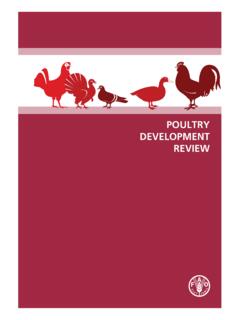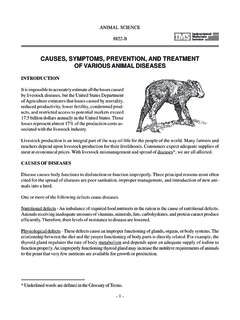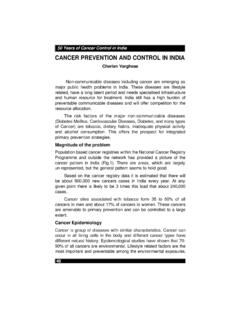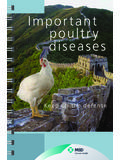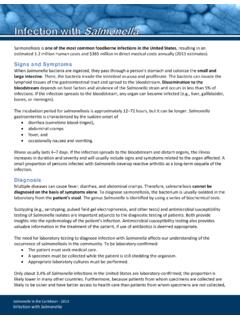Transcription of PREVENTION, DETECTION AND CONTROL OF SALMONELLA …
1 2021 OIE - Terrestrial Animal Health Code - 19/07/20211C H A P T E R 6 . 6 .P R E V E N T I O N , D E T E C T I O N A N D C O N T R O L O F S A L M O N E L L A I N P O U L T R YArticle chapter provides recommendations on the prevention , DETECTION and CONTROL of SALMONELLA in is one of the most common foodborne bacterial diseases in the world. The great majority of Salmonellainfections in humans are foodborne with SALMONELLA Enteritidis and SALMONELLA Typhimurium accounting for a majorpart of the problem. SALMONELLA serotypes and prevalence may vary considerably between localities, districts, regionsand countries and therefore, surveillance and identification of the prevalent SALMONELLA serotypes in humans andpoultry should be carried out in order to develop a CONTROL programme for the most food animal species, SALMONELLA can establish a clinically inapparent infection of variable duration, which issignificant as a potential zoonosis.
2 Such animals may be important in relation to the spread of infection between flocksand as causes of human foodborne infection. In the latter case, this can occur when meat and eggs, or their products,enter the food chain thus producing contaminated and scopeThis chapter deals with methods for on farm prevention , DETECTION and CONTROL of SALMONELLA in poultry , andcomplements the Codex Alimentarius Code of Hygienic Practice for Meat (CAC/RCP 58-2005), Code of HygienicPractice for Eggs and Egg Products (CAC/RCP 15-1976) and Guidelines for the CONTROL of Campylobacter andSalmonella in chicken meat (CAC/GL 78-2011). A pathogen reduction strategy at the farm level is seen as the first stepin a continuum that will assist in reducing the presence of foodborne pathogens in eggs and and biosecurity procedures to be implemented in poultry farms and hatcheries are described on Biosecurity Procedures in poultry recommendations presented in this chapter are relevant to the CONTROL of all SALMONELLA with special attention and , as these are common SALMONELLA serotypes in many countries.
3 It should be notedthat the epidemiology of animal and human salmonellosis in a particular locality, district, region or country is importantfor effective CONTROL of the purposes of this chapter the following definitions apply:Breedersmeans poultry destined for the production of fertile eggs for incubation for the purpose of producing exclusionmeans the administration of defined or undefined bacterial flora to poultry to prevent gutcolonisation by enteropathogens, including the destruction or slaughter of a flock before the end of its normal poultry during the period of laying eggs for human OIE - Terrestrial Animal Health Code - 19/07/2021 Chapter prevention , DETECTION and CONTROL of SALMONELLA in poultryArticle of poultry flocks for SalmonellaWhere justified by risk assessment, surveillance should be carried out to identify infected flocks in order to takemeasures that will reduce the prevalence in poultry and the risk of transmission of SALMONELLA to humans.
4 Samplingmethods, frequency and type of samples required should be determined by the Veterinary Services based on a riskassessment. Microbiological testing is preferred to serological testing because of its higher sensitivity in broiler flocksand higher specificity in breeder and layer flocks. In the framework of regulatory programmes for the CONTROL ofSalmonella in poultry and salmonellosis in humans, confirmatory testing may be required to exclude false positive ornegative methods for samplingDrag swabs: sampling is done by dragging swabs throughout the poultry swabs: sampling is done by walking throughout the poultry house with absorbent material placed over thefootwear of the samples: sampling is done by collecting dust from exhaust fans, screens and other equipment in the samples: multiple fresh faecal samples collected from different areas in the poultry house or caecal samplescollected at the , chick box liners, dead in shell and culled day-old birds at the samples: throughout the hatchery, including inside the sizeRefer to the Terrestrial methodsRefer to the Terrestrial and frequency of testingTime and frequency of sampling for each poultry type are listed below.
5 A) Breeders and hatcheriesi) Breeder flocks before lay Before the end of the first week of life when the status of the breeder flock or the hatchery is notknown or does not comply with this chapter. Within the four weeks before being moved to another house, or before going into production if thebirds will remain in the same house for the production period. One or more times during the growing period if there is a culling policy in place. The frequencywould be determined on commercial ) Breeder flocks in lay At least at monthly intervals during the laying period. Additional testing should be determined by the Veterinary ) Hatcheries Testing at hatcheries should complement on farm testing. The minimal frequency should be determined by the Veterinary ) poultry for the production of eggs for human consumptioni) Flocks grown to be layers Before the end of the first week of life when the status of the breeder flock or the hatchery is notknown or does not comply with this chapter.
6 Within the four weeks before being moved to another house, or before going into production if thebirds will remain in the same house for the production period. One or more times during the growing period if there is a culling policy in place. The frequencywould be determined by commercial prevention , DETECTION and CONTROL of SALMONELLA in poultry2021 OIE - Terrestrial Animal Health Code - 19/07/20213ii) Layer flocks At expected peak of lay for each production cycle (the period of time in the laying cycle when theproduction of the flock is highest). One or more times if there is a culling policy in place or if eggs are diverted to processing for theinactivation of the pathogenic agent. The minimal frequency should be determined by theVeterinary ) poultry for the production of meati)Flocks should be sampled at least ) When sampling occurs on farms and when there is a long period (twoweeks or more) between thinningand final depopulation, further testing should be ) When sampling occurs on farms, flocks should be sampled as late as possible before the first birds aretransported to the slaughterhouse/abattoir.
7 In order to allow for the implementation of CONTROL measuresduring processing, this should be done at a time that ensures the results are available before sampling occurs on the farm, which is more appropriate for consequent CONTROL measures, or at theprocessing plant, there should be an integrated system in place which allows for investigation of the sourceof positive ) Testing of empty poultry housesBacteriological monitoring of the efficacy of disinfection procedures is recommended when SALMONELLA havebeen detected in the previous appropriate, sampling of equipment and surfaces as well as boot swabs or drag swabs of the empty poultryhouse should be carried out after depopulation, cleaning and from surveillance may lead to the implementation of additional prevention and CONTROL measures to reduce therisk of transmission of SALMONELLA to humans:1) In breeders, CONTROL measures may be implemented to reduce the transmission of SALMONELLA to the nextgeneration, especially for trans-ovarian transmitted serotypes such as S.
8 In layer flocks, CONTROL measures will reduce and may eliminate contamination of eggs with ) In poultry for meat production, CONTROL measures may be implemented at slaughter or further down the food and CONTROL measuresSalmonella prevention and CONTROL may be achieved by adopting Good Agricultural Practices and Hazard AnalysisCritical CONTROL Point (HACCP) principles, and general measures detailed in , in combination with thefollowing additional measures, where appropriate. No single measure used alone will achieve effective prevention and CONTROL measures include vaccination, competitive exclusion, use of organic acids, cullingand product diversion to agents should not be used to CONTROL infection with SALMONELLA in poultry because the effectiveness of thetreatment is limited, may mask the infection at sampling, has the potential to produce residues in meat and eggs andcan contribute to the development of antimicrobial resistance.
9 Antimicrobial agents may also reduce normal flora in thegut and increase the likelihood of colonisation with SALMONELLA . In special circumstances antimicrobial agents may beused to salvage birds with high genetic )Day-old birds used to stock a poultry house should be obtained from breeder flocks and hatcheries that have beenmonitored in accordance with this chapter and in which no evidence of and has ) Layer and breeder flocks should be stocked from flocks that have been monitored in accordance with this chapterand in which no evidence of S. Enteritidis and has been )Feed contamination with SALMONELLA is known to be a source of infection for poultry . Therefore, it is recommendedto monitor the SALMONELLA status of poultry feed, and if found positive to take corrective measures. Heat treatedfeed with or without the addition of other bactericidal or bacteriostatic treatments, organic acids, arerecommended.
10 Where heat treatment is not possible, the use of bacteriostatic or bacteridical treatments isrecommended. Feed should be stored in clean closed containers to prevent access by wild birds and feed should be cleaned up immediately to remove attractants for wild birds and feed should be handled and stored in such a way as to avoid OIE - Terrestrial Animal Health Code - 19/07/2021 Chapter prevention , DETECTION and CONTROL of SALMONELLA in poultry4) Competitive exclusion may be used in day-old birds to reduce colonisation by exclusion products should be administered in accordance with the instructions provided by themanufacturer and in accordance with the standards and recommendations of the Veterinary ) Vaccines are used against SALMONELLA infections caused by different serotypes in various poultry species, includingsingle or combined vaccines. Vaccines produced in accordance with the Terrestrial Manual should be live vaccines are used, it is important that field and vaccine strains be easily differentiated in the laboratory.










